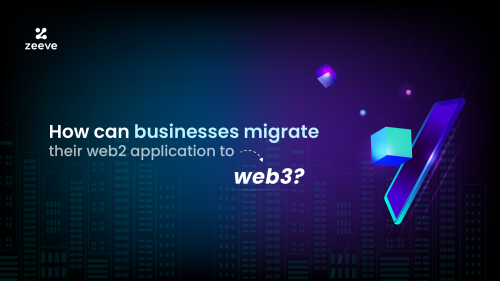
How can businesses migrate their web2 application to web3?
As technology evolves, the need arises for a more advanced, interactive, and user-focused web experience. For example, initially there was a static web; web1 and then arrived web2 (the second and current generation of internet) that brought along interactive functionalities like user-generated content, participatory culture, ease of use, and interoperability.
Now, we all are heading towards a more open, decentralized, and permissionless version of web; Web3. Considering the rapid adoption of web3 technology across major industries, a lot of enterprises are migrating their existing web2 application to the web3 infrastructure.
However, web2 to web3 migration for businesses can be successful only if they have complete understanding of how a web2 application can be seamlessly migrated to web3. If you are looking to migrate your business apps or solutions from web2 to web3, then this guide will help as it covers all the technical aspects and essential information related to the migration process, including the best Web2 to Web3 migration strategies. Let’s start off!
Why businesses are transitioning from Web2 to Web3
Web3 is said to be the third iteration of the internet— the future. Web3 is powered with new-age technologies such as blockchain, cryptography, metaverse, and NFTs. With that, Web2 to Web3 migration for businesses unlocks next-gen features for web3 apps, including data immutability, anti-censorship ability, information encryption, reliable decentralized storage, and complete data privacy.
By leveraging the web3 infrastructure for applications, enterprises or businesses provide their app users with benefits like data ownership revenue-sharing/creator-focused economy, immersive digital experiences, enhanced security, an economy, and freedom from centralized authorities like traditional banks. Therefore, businesses interested in growing with a decentralized web are migrating their existing web2 apps, while many of them are also building web3 apps from scratch.
Demystifying the web3 application architecture
Web3 applications are blockchain-powered apps designed to support the web3 ecosystem. These apps are regulated through the logic programmed in smart contracts running in the backend. Web2 to web3 migration for businesses requires them to have a firm understanding of the web3 application architecture. However, to have a clear overview of web3 architecture, let’s first understand how web3 applications differ from the current web2 apps.
The high-level architecture of web2 apps include three main components– the front-end, backend, and the database. As we know, frontend enables user interaction with the web3 app, backend provides data for the frontend operations, and database is a collection of filtered data. The backend uses APIs (application programming interfaces) to fetch the data based on users’ actions. For example, checking profile information and news feed of social media handles. As you can see in the below image, Web2 apps are based on client-server architecture where the database sits as backend and communication is enabled through APIs.
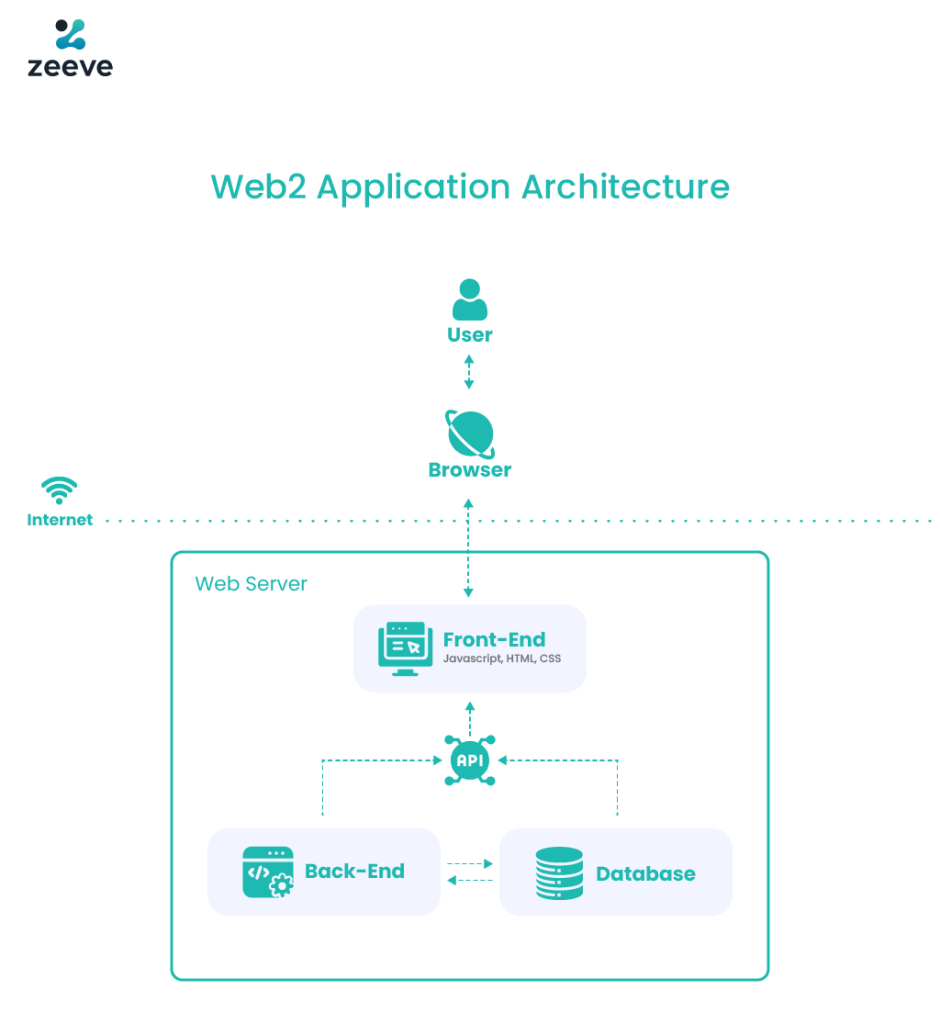
Now to decode the web3 application architecture, we divide the whole structure into three main components– The application front-end, nodes, and blockchain network infrastructure. The application’s front end includes an interface built with javascript, CSS, and HTML. As the image below explains, the front end connects with nodes to access the underlying blockchain infrastructure that consists of smart contracts, EVM, and blocks. The backend is further powered with IPFS and data indexing protocol to store files and retrieve on-chain data, respectively. Access to web3 apps is granted through a ‘Signer’ (wallets such as Metmask) using the web3 wallet authentication method. Collectively, we understand that a web3 application architecture is more complex and unique than a traditional web2 application.
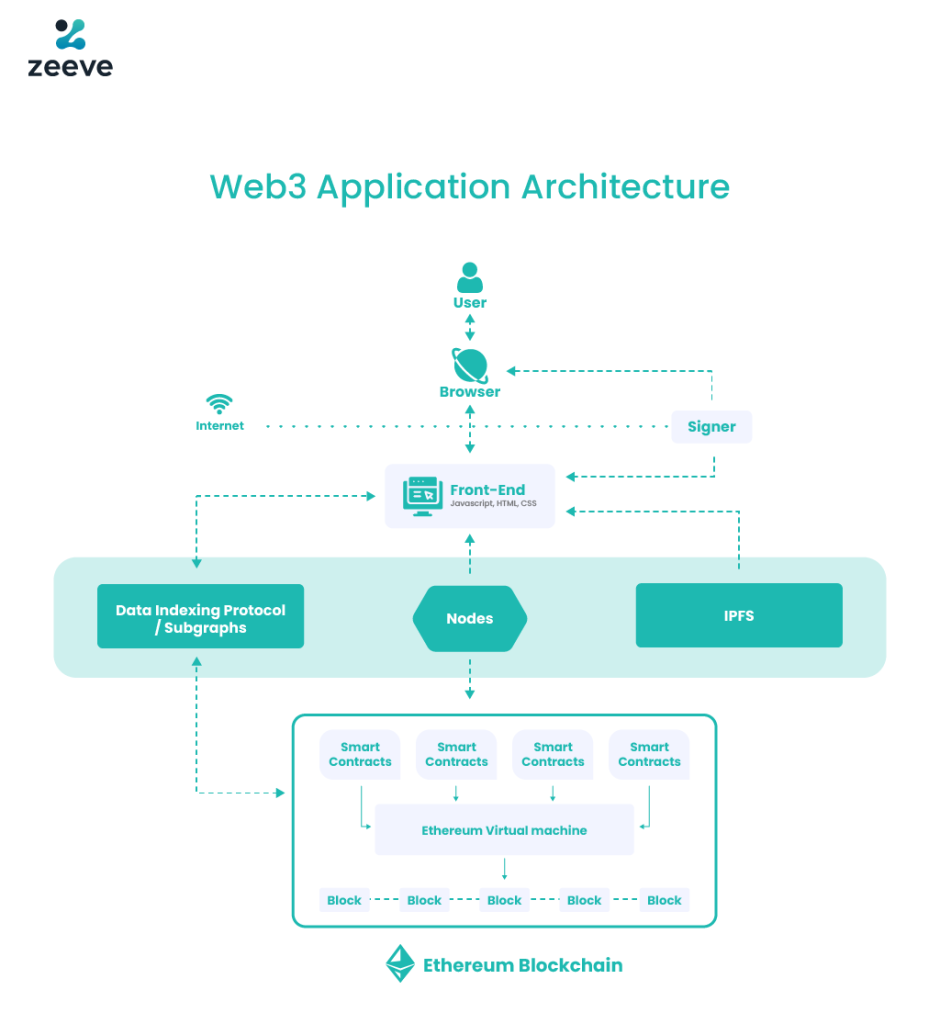
What components you need to migrate from web2 to web3
Following are the main components businesses need to migrate from web2 to web3 application. Based on your web3 applications’ use cases and benefits, you can add/eliminate any relevant component.
Infrastructure Migration
As you already know, web2 applications are based on centralized databases as infrastructure that exist in a single place, for instance a mainframe computer. For web2 to web3 migration, you need to migrate from the centralized infrastructure to decentralized and distributed blockchain infrastructure, which has unique attributes like tamper-resistant, fully-transparent, and excellent reliability. The blockchain infrastructure consists of various nodes that are distributed worldwide that interact with the network and approve blocks to be added further into the chain. Furthermore, smart contract is an essential aspect of web3 application infrastructure—- blockchain as it allows the underlying network to run on the predefined conditions. Basically, the front-end and user experience will remain the same despite web2 to web3 application migration, only the backend will change.
Data Storage Solutions
Web2 to web3 migration for businesses makes no impact on the storage solutions. Enterprises must use AWS, Digital Ocean, and Azure because using blockchain to store all the web3 app content and user-generated data is inefficient, unlike popular web2 apps such as Facebook and Twitter, which allow users to upload endless images, files, and videos through integrated, scalable storage systems. Therefore, you can continue with storage providers. And, If you want to distribute their data all over the distributed web, then use IPFS, which powers a highly secure and reliable peer-to-peer storage system for all types of applications.
Off-chain data solution- Oracles
Oracles are third-party services that allow smart contracts to interact with and access off-chain data existing outside of the blockchain ecosystem. Looking into the web2 environment, APIs facilitate real-world data retrieval. Likewise, web3 apps rely on off-chain data solutions like Oracles to fetch off-chain information. Oracles are both centralized and decentralized, but using a decentralized Oracle may offer higher trust and security.
Payment gateway
For a Web3 solution, a typical payment gateway remains a viable component for accepting debit, credit card, and other fiat transactions. However, if your dApp needs to interact with blockchain for any purpose or you want to offer crypto-related services like trading and exchanges of cryptocurrencies in your dApp, then you need a web3 wallet. Web3 wallets allow your app users to manage, store, and exchange crypto assets, digital assets, and fungible and non-fungible tokens, and meanwhile, allow you to interact with a range of other web3 apps that are open-source.
All the activities on a web3 wallet are done in a purely decentralized and non-custodial way. Users have complete control over their funds, keys, and data ownership. No centralized or third party can interrupt the concealed privacy. These wallets’ security is maintained through private keys and seed phrases that are non-recoverable once lost. Metamask is one such popular Ethereum-based crypto wallet that offers features like non-custodial, multi-signature, and open-source ecosystem.
Codebase migration
Codebase migration in web2 to web3 applications refers to transferring your existing code database from centralized to decentralized blockchain environment. There are mainly three types of codebase migration performed in web3 development— transitioning to a different programming language (for example, Javascript to Solidity, moving to a different version of a language (e.g. Javascript ES11 to ES12, and moving to another operating system (e.g. Linux to Windows).
Depending on the blockchain you are choosing, the language preference changes. In the earlier days, Solidity was preferred the most, now-a-days, there are multiple blockchains where you can use Javascript or Web2 familiar languages.
User flow changes
User flow in the web3 application is similar to the web3, but the difference is reflected in terms of enabling content ownership. Let’s see an example of this. Suppose you have a gaming app, that you have migrated from web2 to web3 ecosystem. Here, the user flow will remain the same unless you want to add some NFTs or crypto-dedicated features like allowing players to mint, create, and trade NFTs. When doing this, you will need wallets, tokens, and private keys to sign the transactions. Otherwise, user flow won’t change.
Tech stack for migrating web2 apps to web3
Web2 to Web3 migration for businesses need to leverage a range of tech stack on different layers of web3. Let’s dive deeper into each layer and learn about the corresponding web3 stack.
Layer-1: Blockchain
Blockchain provides decentralized infrastructure to run your web3 application, serving as the first web3 layer. While choosing a blockchain, be sure to consider multiple factors like decentralization, gas fee, transaction throughput, response time, interoperability, and many more things. You can choose any blockchain you want, but making a selection based on use-case-specific parameters is the best way because each blockchain has its strengths and weaknesses. For example, enterprises usually start with Ethereum as it has massive influence across the developer community and a comprehensive set of web3 stack. Likewise, you can consider migrating to Layer-2 scaling solutions and application-specific blockchains like Cosmos Zones, Parachains, Supernets, and Subnets.
Layer-2: Blockchain Nodes
For production-grade deployment of your web3 application, you need a server. Blockchain nodes do this for you as these are the devices or network stakeholders (servers) that store transaction history across the peer-to-peer network, sync, store, and keep a copy of distributed data while simultaneously validating new blocks. Nodes are authorized to run the ‘blockchain software’ that serves as a communication channel between your web3 app and the distributed blockchain database. Running blockchain nodes on your own can be a complex and time-consuming process. Fortunately, there are many node-as-a-service providers offering ready-to-use nodes for you. As such, app businesses do not have to worry about setting up nodes and maintaining their performance.
Layer-3: Application programming interfaces (APIs)
APIs are a set of protocols that allow dApp developers to interact with various blockchains and access the precompiled or indexed data along with network’s functionality without having to build their dedicated blockchain platform. You will have several reputable web3 API providers in 2023 that offer high reliable endpoints, enabling you to get the fastest response on queries. Note that APIs are a great way for querying data from blockchain, but for large dApps, developers have to run a lot of queries at once. And, therefore, running a dedicated node is a better option in this case. For more information on API and nodes, read a detailed comparative guide.
Shared APIs vs Dedicated Nodes: Which is a viable option for your dApp
Layer-4: Decentralized applications (dApps)
Decentralized apps in the web3 stack layer represent the development stage, where you need to design the user interface for your web3 apps, choose the hosting services, and set up the backend to establish app’s seamless communication with blockchains. To accomplish all these, you need a range of web3 tech stack such as, nodes, APIs, peer-to-peer database for storing on-chain data and reliable hosting services like AWS, Azure, and Firebase. With this tech stack in place, enterprises can easily design a web3 application that offers great end-to-end experience.
Moving on, to enhance the usability of your web3 application and delimiting the development boundaries, you need a bunch of supporting stack, including the following:
- Web3 clients— web3.js, Anchor, Ethers.js.
- Layer-2s, sidechains, and Appchains— Polygon, ZK Sync, Arbitrum, Optimism.
- Web3 development environment— Truffle, Foundry, Hardhat, Anchor.
- Blockchain indexing protocol- The Graph and SubQuery Network
- Mobiles SDK’s- web3j/web3j– a lightweight Java and Android library for integration with Ethereum clients
- Web and BackEnd SDKs- ChainSafe pr web3.js: Ethereum JavaScript API
How to migrate your web3 apps to web3
Now that we understand the architecture of the web3 application, all the essential tech stack, and migration logic– let’s go through the step-by-step process of web2 to web3 migration for businesses:
- Gather requirements and use cases: Before starting the migration process, you must First, list features and functionalities your end users wish to see in the web3 app. For example, determine if your web3 app needs to support cryptos/NFTs, what specific features it will support, scalability parameters, and so on.
This process demands intense research, community support, and hypothesis testing. Also, determine the existing use cases of your web2 application that can be refined using blockchain technology, such as secure transactions, data integrity, higher transparency, and decentralized identity management. - Choose a blockchain ecosystem: Next, choose a blockchain ecosystem that fulfills your use case-specific requirements. Further, determine if you need a public or permissioned blockchain network. Popular public blockchains you can consider are Ethereum, Near, Tezos, and Polygon. Permissioned/Enterprise blockchains include Cosmos, Corda, Hyperledger Fabric, Hyperledger Besu, and R3 Corda.
- Program the smart contract: Based on the shortlisted features and the functionalities, program custom smart contract that powers the backend of your web3 app, allowing the code to be triggered once the written agreement parameters are met. that require smart contracts and design them accordingly.
- Perform integration: To make your web3 app composable, you need to integrate web3 libraries, APIs, Node endpoints, SDKs & frameworks, dev tools and resources like docs and codebase that are relevant to your application. These integrations allow web3 developers to interact with your app, fetch and query data from its ecosystem, use smart contract logics, and build other applications on top of it. Thereby, your web3 app gets a rich ecosystem of innovative web3 projects.
- Test thoroughly and make upgrades: At this stage, you need to rigorously test your smart contract to find out vulnerabilities and make the required modifications.
- Deploy your web3 app: Finally, deploy your web3 application to the mainnet. Remember to follow the best deployment practices such as gas cost optimization, adding a network-level robust security mechanism, and monitoring features.
How much does it cost for app businesses to migrate from web2 to web3?
The total cost of web2 to web3 application migration depends on a number of factors. Hence, quoting a specific cost is difficult. Based on your requirements, a web2 to web3 migration service provider will determine the overall cost. Speaking about the top factors that affects the cost of Web2 to Web3 migration for businesses, we come across the complexity of your web3 app, integration requirements, sets of features to include, expertise of the development team you hire, project turnaround time, level of in-built security features, UX design, decentralized storage selection, and post-deployment facilities such as monitoring and maintenance of your web3 app.
Web2 to web3 application migration with Zeeve
Migration of web2 applications to web3 has been happening on a rapid scale, and more enterprises are joining this trend to leverage the excellent benefits of web2 to web3 migration for businesses, thereby staying at the forefront of innovation. Considering this, Zeeve offers web3 migration assistance to all kinds of web2 enterprises, startups, and blockchain-based businesses. We have a dedicated team of Web3 experts and DevOps engineers to support a hassle-free and cost-efficient migration of your existing web2 apps to a decentralized web3 infrastructure. Also, if you are planning to migrate a large dApps with millions of daily active users, Zeeve offers seamless deployment of your dApp to an independent, single-use blockchain infrastructure through AppChain development. For more details on our blockchain-related services, you can talk to our consultants anytime.



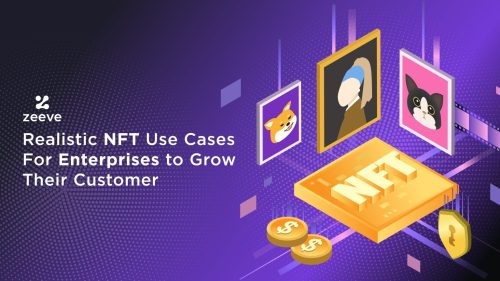


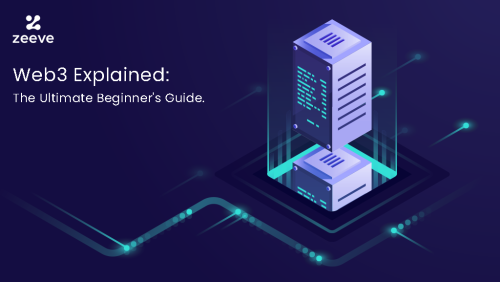

Responses